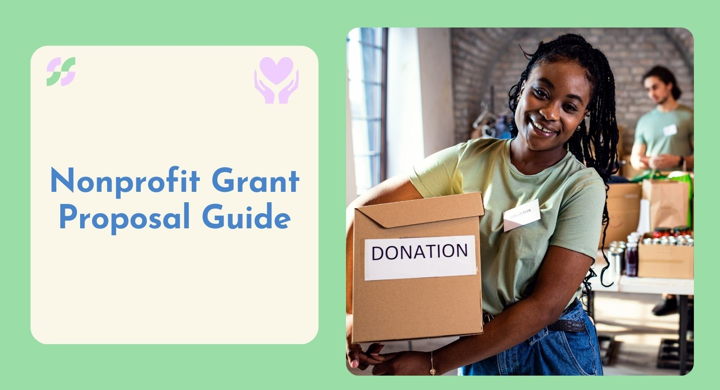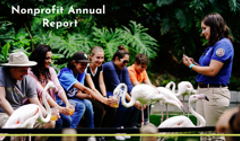As we move through 2026, the role of nonprofits remains as vital as ever. These organizations step in where governments can’t—or won’t—take on challenges that shape our communities and highlight our shared responsibility for the world we live in. Whether it's education, human services, the arts, or public advocacy, nonprofits continue to be a driving force for meaningful change.
Fortunately, philanthropy has been on the rise. In 2024, nine out of ten nonprofit sectors saw increased donations. At the same time, grant success rates hover between 43% and 46%, meaning nearly half of all grant proposals fail to secure funding.
With nonprofits increasingly vying for limited grants, writing a compelling funding proposal becomes even more crucial. Whether you're a seasoned nonprofit professional or new to the process, this guide will walk you through the essential steps to crafting a proposal that stands out—helping you secure the funding your organization needs to make a lasting impact.
Key Takeaways
🚀Grants are competitive but essential. Grant writing can open doors to funding sources that are vital to your project’s success. In a competitive landscape, a professional, well-crafted proposal and regular nonprofit reports are your chance at winning.
🚀Know what funders look for. Grant-making organizations want to support projects that align with their mission and demonstrate measurable impact. Invest in research to find the right funding opportunities.
🚀Learn to put together a great proposal. A successful grant proposal includes a compelling cover letter, a well-structured executive summary, a clear statement of need, a detailed project plan, and a transparent budget breakdown.
🚀Make sure your proposals stand out. To make an impression, proposals must be clear, persuasive, and well-researched. Using engaging formats like digital flipbooks can also help grab funders' attention.
What Is a Grant Proposal?
A grant proposal is a formal document submitted to an organization, government agency, or foundation requesting financial support for a specific project, program, or initiative. It outlines the purpose, objectives, methods, budget, and expected outcomes of the proposed work.
Key сomponents of a grant proposal include:
⭐Cover letter. A brief introduction summarizing the request.
⭐Executive summary. A concise overview of the project.
⭐Statement of need. Explanation of the problem or issue to be addressed.
⭐Project description. Details on objectives, methods, timeline, and expected impact.
⭐Budget. A breakdown of funding requirements.
⭐Organization information. Background on the applying entity.
⭐Evaluation plan. Methods for measuring success.
When it comes to grant proposal formats, always check the specific guidelines from the funding organization, as they often have preferred formats and submission methods. The most common formats include PDFs, Word documents, and PowerPoint presentations.
If no specific format is required, we recommend going with a digital flipbook. Online tools like FlippingBook can transform your plain PDFs into interactive proposals with an authentic reading experience and a smooth page flip effect. A flipbook can make your proposal stand out and reflect your nonprofit’s creativity and commitment to presenting your project professionally. Check out how your digital grant proposal example can look:
Grant proposal template courtesy of Andrew Daily Creative on Canva
Create your interactive proposal today
Another advantage of a flipbook proposal is that it’s available via a direct link, so you can easily share it over email, messenger, or embed it into your website. Thus, you can reach a wider audience and make your proposal instantly accessible and easy to read.
💡 Don't have a ready PDF yet?
Choose a nonprofit grant proposal template from Canva’s library, customize it, and publish it to FlippingBook via a handy integration. Just as we did with the example above.
Why Grant Funding Is Crucial for Non-Profits
The greatest benefit of a grant can be summed up in two words: financial flexibility. It provides an organization with the breathing room to plan its activities over a given period without the constant need for fundraising campaigns.
Grant writing can open doors to funding sources that are essential to your project’s success. In fact, submitting three to five grant applications could give you a 90% chance of securing at least one. So don’t hesitate to seek out the right fund—one that is eager to support your initiative. Keep in mind that grant-making entities want to invest in projects and initiatives that create a meaningful impact on the issues they care about.
How to Write a Powerful Grant Proposal: Step-by-Step Guide
Grants are a vital funding source for nonprofits, so it's always wise to apply for the right opportunities when they arise. While many generous funding organizations exist, competition can be fierce. To stand out, you’ll need a clear and compelling funding proposal that demonstrates why your organization is the ideal grant recipient. Follow our key steps to craft a strong grant proposal.
#1 Research grant opportunities 🔍📚
Take your time and research the nonprofit grant opportunities that can apply to your organization. Don’t forget to check eligibility requirements and deadlines for a grant and learn about past grant recipients to understand what funders are looking for.
The most important thing to focus on is to find a foundation or company that has similar values to your nonprofit—there’s a big chance that they offer grants that are well-suited to your funding needs. For example, if your nonprofit focuses on supporting sustainability and the environment, you might look for other businesses that do the same. If one of these companies offers a grant program, you may be more likely to qualify.
Location can also help you find suitable grants for your nonprofit. Many community groups offer nonprofit grants specifically to organizations within their state, city, or local area. Your state or local government may issue nonprofit grants as well.
There are many useful resources to find grant opportunities for nonprofits. Here are some of the best places to search:
- Grants.gov. A comprehensive database of federal grant opportunities in the U.S.
- GrantStation. Features global grants for nonprofits, with a membership required for full access.
- GrantWatch. Lists international grants for nonprofits, though some content requires a subscription.
- Candid (Foundation Directory Online). Provides grant opportunities from international and U.S.-based funders.
- United Nations (UN) Grants. Various UN agencies (e.g., UNICEF, UNDP, UNESCO) offer global funding for nonprofits.
- Walmart Foundation. Offers grants for community-focused projects.
#2 Write a strong cover letter ✍️📄
Every grant proposal should start with a cover letter. This is your first chance to signal to the funding organization that you’re an ideal match, so make it easy for them to want to continue reading. Here are the main things to consider when writing a cover letter:
- Your letter should be short, sweet, and to the point. Use space wisely to make your cover letter no more than four paragraphs long.
- Say what you need. At the beginning of the cover letter, mention how much money you need and for what purpose.
- Don’t be afraid to be direct—you deserve this grant, so make sure the reader knows it.
- Explain the problem your nonprofit addresses and highlight the project and its impact.
- Show understanding of the funder’s mission and priorities and connect your project to their goals.
#3 Create a compelling executive summary 📑✨
After your cover letter, add a summary of your proposal. This gives a clear overview of your project and how the grant funds will be used.
Think of the executive summary as a quick guide to your proposal—it should highlight the most important details and help the reader understand your goals right away. Including a table of contents can also make it easier for the funder to find key information quickly. Here are some essential questions a good grant writer will address:
✅ What is the organization’s mission and history? What does the organization do?
✅ What is the project and why is it important? A brief, clear description of what you’re proposing and the problem or need your nonprofit is addressing.
✅ How does this project align with the funder’s mission? Show why your initiative is a good fit.
✅ How will the funds be used and what are the expected outcomes? A high-level breakdown of how the grant money will be allocated. And the impact and measurable results you plan to achieve.
✅ What is the timeline for implementation? Key milestones and expected completion.
#4 Introduce your organization 🏢💡
Now that you've laid the groundwork for your funding proposal, it's time to introduce your organization. Share key details about your history, mission, and experience, along with any relevant information about your team and infrastructure.
This is also a great place to highlight success stories that showcase your impact and expertise. Be sure to include information about key staff members and explain your organization’s goals and overall philosophy. Highlight your track record of responsible fund usage and explain why you are the best fit for this funding opportunity.
#5 Write your statement of need 📣🔎
Problem statement is one of the most important parts of your grant proposal. This is the place where you describe the problem you want to address, how you can solve it, and why your solution will make a difference.
An impactful statement of need is based on heavy research, data, and real-world examples to support your case. Here’s how you can structure it:
- Identify the problem. Clearly describe the issue or challenge your project is working with. Use data, research, or real-life cases to demonstrate the urgency and scale of the problem.
- Explain why it matters. Show how this issue affects the community, target population, or environment. Highlight the consequences of not addressing the problem.
- Provide context. Offer background information on why the problem exists. Include relevant facts or trends that help the reader understand the broader context.
- Link to your mission. Tie the need directly to your nonprofit’s mission, explaining how your project aligns with your overall goals.
#6 Outline your project goals and objectives 🎯📊
Clearly stating your goals and objectives is a key to a winning funding proposal. Many proposals fail because they lack clarity or do not explain how success will be measured. Make sure to distinguish between broad aspirations and specific, measurable steps, providing detailed descriptions for each:
- Define your goal. Describe it as broad, mission-driven, and having long-term impact (What’s the big-picture purpose?)
- Set SMART objectives. Specific, measurable, achievable, relevant, time-bound (How will you achieve the goal?)
#7 Develop a detailed project plan 🗂️📅
The project plan should be clear, organized, and show how the work will be completed effectively. Write it from the perspective as if you’ve already received funding and are planning what activities you want to fund.
- List the specific tasks and actions you’ll take to achieve your goals and objectives. Break them down into manageable steps.
- Create a timeline. Develop a clear timeline with milestones and deadlines for each activity. Show when things will happen and how they’ll progress.
- Assign responsibilities. Determine who will be responsible for each task—whether it's a team member, volunteer, or partner.
- Budget breakdown. Provide a detailed budget, showing how the grant funds will be used for each part of the project (e.g., staffing, materials, equipment).
#8 Outline your project budget 💰📈
One of the most crucial elements of any funding request is, of course, the budget. A well-prepared budget helps the grantmaker see that you’ve carefully considered all costs and know how to manage the funds. Include the following information:
- Budget summary. Provide the total budget, amount requested, and any matching funds.
- Expense categories. Break down costs into major categories (personnel, program, administrative, travel, etc.).
- Justify costs. Explain why each expense is necessary.
- Cost sharing/contributions. Mention any additional funding or donations.
- Expenditure timeline. Outline when funds will be spent during the project.
#9 Include an evaluation plan 📊✅
An efficient evaluation plan will demonstrate to funders that you are committed to tracking the impact of your project, making adjustments as necessary, and ensuring long-term sustainability.
- Start by explaining the purpose of the evaluation, emphasizing how it will help track progress toward your goals and assess long-term outcomes.
- Next, describe how you’ll collect data, including both quantitative and qualitative methods.
Include a timeline that shows when evaluations will occur, such as during the project or at key milestones. - Specify who will be responsible for conducting the evaluation, whether it's internal staff or external experts.
- Finally, explain how the results will be shared with stakeholders and used to inform future projects or improve the current one.
💡 Pro tip: Want your PDF reports to get noticed? Transform them into stylish online reports with a page flip effect, embedded videos, and GIFs.
Final Thoughts
Securing grant funding may take time, but with determination and a professional grant proposal, your nonprofit can set itself apart from the competition and get great funding opportunities. Keep refining your approach, stay committed to your mission, and take each step as a learning experience. There are generous funders out there eager to support impactful projects—your nonprofit could be the next one they believe in. Keep writing, keep applying, and know that success is within reach!





